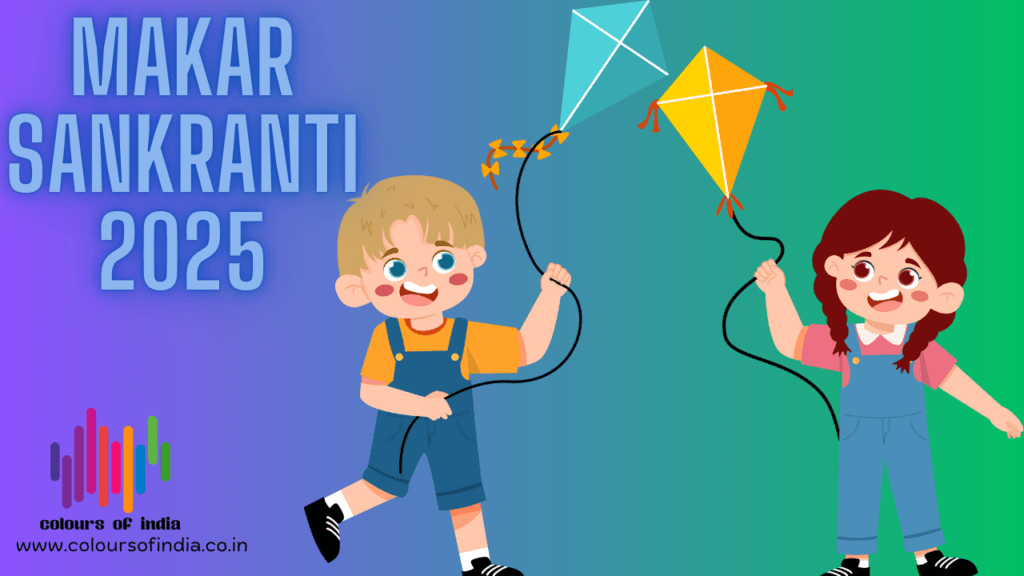MAKAR SANKRANTI 2025
Makar Sankranti is a significant Hindu festival marking the Sun’s transition into Capricorn (Makara Rashi), symbolizing the end of winter and the onset of longer, warmer days. In 2025, Makar Sankranti falls on Tuesday, January 14. Makar Sankranti is a solar festival, unlike other Hindu festivals based on the lunar calendar.
It marks the Sun’s northward journey (Uttarayana) and its entry into Makara Rashi (Capricorn). The day symbolizes the end of winter solstice and the beginning of longer, sunnier days. Uttarayana is considered an auspicious time in Hindu scriptures. Many believe that leaving the mortal world during this period ensures liberation (moksha).

Historical Background
- Makar Sankranti has been celebrated since ancient times, mentioned in the Mahabharata and Vedic texts.
- It is associated with King Bhagiratha bringing the Ganges to Earth and Bhishma Pitamah choosing this period to leave his mortal body.
Makar Sankranti and Astrology
- Makar Sankranti marks the Sun’s movement into Capricorn, ruled by Shani (Saturn). The alignment signifies discipline, transformation, and growth.
- Many perform Surya Namaskar (Sun Salutation) and chant the Gayatri Mantra to invoke blessings.
Timings for Makar Sankranti 2025:
- Sankranti Moment: January 13, 2025, at 7:33 PM
- Makara Sankranti Punya Kala: January 14, 2025, from 7:21 AM to 5:13 PM (Duration: 9 hours 52 minutes)
- Makara Sankranti Maha Punya Kala: January 14, 2025, from 7:21 AM to 8:59 AM (Duration: 1 hour 39 minutes)
Regional Names and Celebrations
Maharashtra:
- People exchange sesame-jaggery sweets (tilgul laddoos) and say, “Tilgul ghya, god god bola” (Take these sweets and speak sweetly).
- Married women are invited for Haldi-Kumkum ceremonies.
Gujarat:
- Known as Uttarayan, kite flying is a major activity. The sky is filled with colorful kites as people celebrate the Sun’s new journey.
- A special dish called Undhiyu (mixed vegetables cooked with spices) is prepared.
Punjab:
- The festival is celebrated as Lohri on January 13. People gather around bonfires, sing traditional songs, and enjoy gajak, rewri, and popcorn.
- Lohri is significant for farmers, marking the harvest of rabi crops.
Tamil Nadu:
- Celebrated as Pongal, a four-day festival dedicated to the Sun God. Each day has its significance:
- Bhogi: Bonfires to discard old items.
- Thai Pongal: Offering sweet rice (Pongal) to the Sun.
- Mattu Pongal: Honoring cattle.
- Kaanum Pongal: Social gatherings and family visits.
- Celebrated as Pongal, a four-day festival dedicated to the Sun God. Each day has its significance:
Assam:
- Known as Magh Bihu or Bhogali Bihu, it marks the harvest season.
- People build temporary huts (Mejis) and have community feasts.
Karnataka and Andhra Pradesh:
- Known as Sankranti, people decorate their homes with rangoli, prepare sweets, and exchange gifts.
Bihar and Uttar Pradesh:
- Known as Khichdi, devotees take a dip in holy rivers and prepare rice-lentil dishes (khichdi). Donating items like blankets, food, and sesame is common.
Traditional Practices:
- Kite Flying: Especially popular in Gujarat and Rajasthan, symbolizing the ascent to the heavens.
- Bonfires and Folk Songs: Central to Lohri celebrations in Punjab.
- Special Dishes:
- Til-gur laddoos (sesame and jaggery sweets) in Maharashtra, exchanged with the phrase “Tilgul ghya, god-god bola” (Eat sweets, speak sweetly).
- Sakkarai Pongal in Tamil Nadu, a sweet rice dish made with jaggery and ghee.
- Undhiyu in Gujarat, a mixed vegetable dish prepared with seasonal produce.
- Khichdi in northern India, made with rice, lentils, and spices.
Traditional Foods
- Tilgul Laddoos: Made with sesame seeds and jaggery, believed to keep the body warm and strengthen bonds.
- Puran Poli: A flatbread stuffed with sweet lentil filling, popular in Maharashtra.
- Sakkarai Pongal: Sweet rice with jaggery, a hallmark dish of Tamil Nadu.
- Makara Chaula: A special dish from Odisha, made with rice, jaggery, banana, and chhena (cheese).
- Churma Laddoos: Traditional Rajasthani sweet balls made with wheat flour, ghee, and jaggery.
Makar Sankranti and Kumbh Mela 2025:
In 2025, Makar Sankranti coincides with the Maha Kumbh Mela in Prayagraj, a once-in-12-years event commencing on January 13, 2025, and concluding on February 26, 2025. The festival is expected to attract around 400 million visitors. Significant bathing dates during the Kumbh Mela include:
- January 13: Paush Purnima (First royal bath)
- January 14: Makar Sankranti (Grand royal bath)
- January 29: Mauni Amavasya (Grand royal bath)
- February 3: Basant Panchami (Royal bath)
- February 12: Magh Purnima (Royal bath)
- February 26: Maha Shivaratri (Royal bath)
For the detailed information about Kumbh Mela Click Here.
Global Celebrations
- In Nepal, it is celebrated as Maghe Sankranti, a day of bathing in rivers and eating sesame sweets.
- The diaspora in countries like the USA, UK, and Australia celebrates Makar Sankranti with community events, kite festivals, and feasts.
Why Two Days in Some Years?
- In some years, the Sankranti moment (the exact time of the Sun’s transit) occurs late in the evening, pushing celebrations to the next day.
- For 2025, the Sankranti moment is on January 13 at 7:33 PM, making January 14 the day of observance.
Click on the photo to buy the following new items on Makar Sankranti.